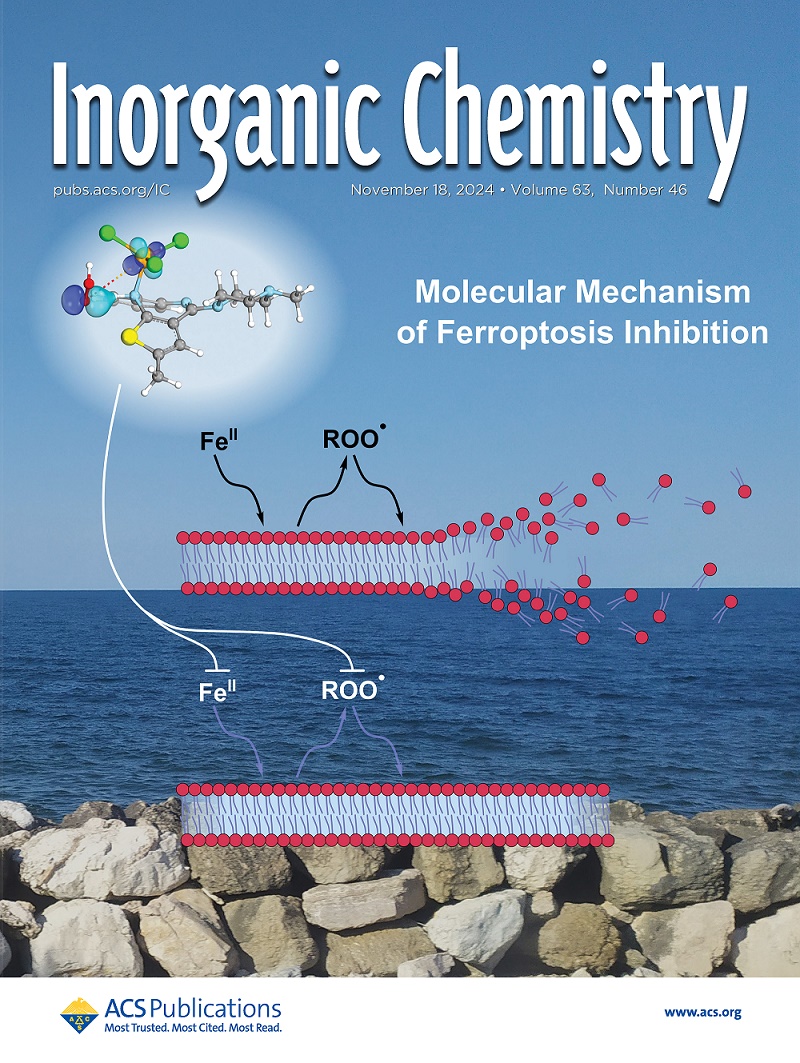Dual Functions of Fluorescence and Peroxidase Mimics for Hemin@NH2-UiO-66 and Ratiometric Fluorescence Sensing to l-Cysteine.
IF 4.3
2区 化学
Q1 CHEMISTRY, INORGANIC & NUCLEAR
引用次数: 0
Abstract
The bifunctions of fluorescence activity and peroxidase mimics were well-integrated by a hemin chloride-modified Zr-based metal-organic framework (Hemin@NH2-UiO-66), which can catalyze the oxidation of o-phenylenediamine (OPD) to generate 2,3-diaminophenazine (DAP), presenting typical peroxidase mimic properties. The influence of the introduction of hemin chloride upon the enhanced peroxidase mimic activity was clarified, and the nanozyme catalytic parameters were optimized. Interestingly, the oxidized product of DAP presents strong fluorescence emission at 564 nm; combining it with the intrinsic fluorescence emission of NH2-UiO-66 at 452 nm, a dual-emission system could be built up by the resulting Hemin@NH2-UiO-66 in the presence of definite OPD and H2O2. Moreover, the fluorescence quenching effect (564 nm) was observed by adding l-cysteine (l-Cys); based on that, a straight-line dependence of the fluorescence intensity ratio (I452/I564) upon the concentrations of l-Cys was established. The detection limit was 0.21 μmol, and the analytical selectivity for l-Cys was also demonstrated. The work highlights the idea of combining the intrinsic fluorescence property and nanozyme catalytic activity in a functional MOF, and its special usability is found in the ratiometric fluorescence sensing analyses.荧光和过氧化物酶模拟物Hemin@NH2-UiO-66的双重功能及对l-半胱氨酸的比例荧光传感。
通过氯化血红修饰的锆基金属有机骨架(Hemin@NH2-UiO-66),将荧光活性和过氧化物酶模拟物的双重功能很好地结合起来,催化邻苯二胺(OPD)氧化生成2,3-二氨基苯那嗪(DAP),呈现出典型的过氧化物酶模拟物性质。研究了氯化血红素对提高过氧化物酶模拟活性的影响,并优化了纳米酶的催化参数。有趣的是,DAP的氧化产物在564 nm处有很强的荧光发射;将其与NH2-UiO-66在452nm处的本征荧光发射相结合,在确定的OPD和H2O2存在下,得到Hemin@NH2-UiO-66双发射体系。加入l-半胱氨酸(l-Cys)后,观察到荧光猝灭效应(564 nm);在此基础上,建立了荧光强度比(I452/I564)与l-Cys浓度的直线关系。检出限为0.21 μmol,对l-Cys具有良好的选择性。这项工作强调了在功能性MOF中结合固有荧光特性和纳米酶催化活性的思想,并且在比率荧光传感分析中发现了它的特殊可用性。
本文章由计算机程序翻译,如有差异,请以英文原文为准。
求助全文
约1分钟内获得全文
求助全文
来源期刊

Inorganic Chemistry
化学-无机化学与核化学
CiteScore
7.60
自引率
13.00%
发文量
1960
审稿时长
1.9 months
期刊介绍:
Inorganic Chemistry publishes fundamental studies in all phases of inorganic chemistry. Coverage includes experimental and theoretical reports on quantitative studies of structure and thermodynamics, kinetics, mechanisms of inorganic reactions, bioinorganic chemistry, and relevant aspects of organometallic chemistry, solid-state phenomena, and chemical bonding theory. Emphasis is placed on the synthesis, structure, thermodynamics, reactivity, spectroscopy, and bonding properties of significant new and known compounds.
 求助内容:
求助内容: 应助结果提醒方式:
应助结果提醒方式:


